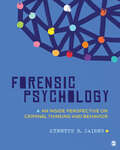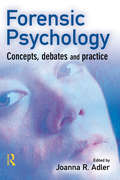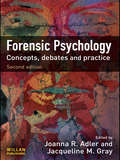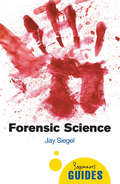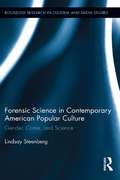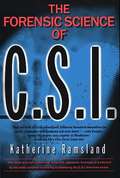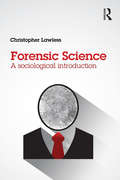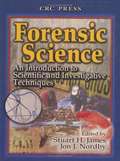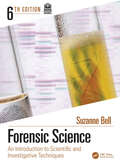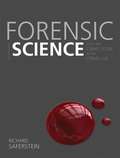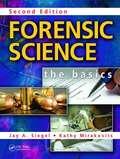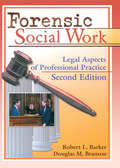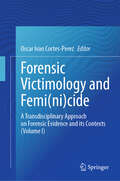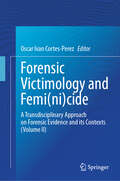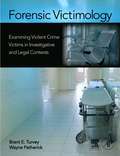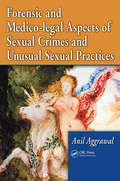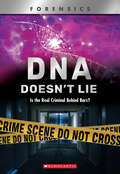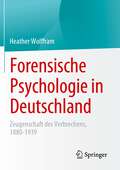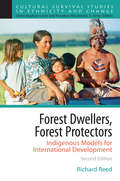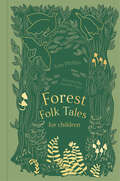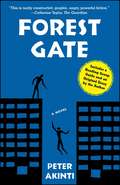- Table View
- List View
Forensic Psychology: An Inside Perspective on Criminal Thinking and Behavior
by Kenneth B. CairnsForensic Psychology: An Inside Perspective on Criminal Thinking and Behavior offers undergraduates a concise, accessible introduction to the field of forensic psychology. With more than 20 years of experience as a forensic psychologist working with incarcerated people, Dr. Kenneth B. Cairns provides a balance between not just forensics and psychology, but also between theory and practical application. Grounded in the cognitive-behavioral approach and evidence based-practices and research, this text will focus on often-overlooked areas, such as the experiences of victims and first responders and the psychopathy of individuals convicted of mass murder, spree killing, and serial killing.
Forensic Psychology: Concepts, Debates And Practice
by Joanna R. AdlerThis book brings together a team of experts in the field of forensic psychology to demonstrate the scope of the discipline and the techniques employed in key areas of research, policy and practice. Its aim is to go beyond the introductory texts on the subject to challenge perceptions, to raise questions for research, to pose problems for practice, and to inspire and stimulate, demonstrating the ways in which forensic psychology can aid the practice of criminal justice. It will be essential reading for students, academics and practitioners. The book is divided into seven sections, addressing key topics with which the discipline is concerned − its broader context, investigation and prosecution, testimony and evidence, correlates of criminality, persistent offending, intervention and prevention and punishment and corrections. The contributors include both academics and practitioners, and are drawn from the UK, the USA and Australasia.
Forensic Psychology: Concepts, Debates and Practice
by Joanna R. Adler Jacqueline M GrayThis book brings together academics, practitioners and experts in the field of forensic psychology to demonstrate the scope of the discipline and push its parameters. Its aim is to go beyond introductory texts to challenge perceptions, to raise questions for research and to pose problems for practice. The editors hope to inspire and stimulate debate about how forensic psychology can aid the practice of justice. The book is divided into six sections, addressing key topics from the discipline: investigation and prosecution; testimony and evidence; serious and persistent offending; treatment as intervention; intervention and prevention and punishment and corrections. The contributors are drawn from the UK, the USA and Australia.This updated, revised and significantly expanded edition develops the picture of diversity and depth of forensic psychology; considers ways in which the discipline has progressed and identifies challenges for its future sustainability and growth. includes a new section on treatment as intervention with contributions on personality disordered offenders; anger control group work with forensic psychiatric inpatients; and developments in treatment for drug misuse offenders additional chapters throughout including contributions on UK police interviews; the investigation and prosecutoin of rape; the effect of gender in the courtroom; forensic psychology and terrorism; the aetiology of genocide; self harm in prisons; post-corrections reintegration and many more an innovative textbook on forensic psychology exploring application of the subject and setting forensic psychology in a broader context demonstrates ways in which forensic psychology can aid the practice of criminal justice This book will be essential reading for students of forensic psychology and practitioners working in the field.
Forensic Science
by Jay SiegelIn the wake of the phenomenal success of such shows as CSI, forensic science has never been so popular. The obsessive attention to detail that Grissom and his crew afford seemingly insignificant details, such as particles of dirt in a bullet wound and the presence of pollen in tyre tracks, have had audiences eager to know more. Siegel's study follows the course of evidence all the way from the crime scene right through to the court judgement, investigating the many types of evidence, how they occur in crimes, how they are collected and analyzed by scientists, and how the results are presented in court. Packed with real examples, the book covers all the major areas of forensic science including drugs, trace evidence, pathology, entomology, odontology, anthropology, crime scene investigation, and law.
Forensic Science
by Jay SiegelIn the wake of the phenomenal success of such shows as CSI, forensic science has never been so popular. The obsessive attention to detail that Grissom and his crew afford seemingly insignificant details like particles of dirt in a bullet wound have had audiences eager to know more. Siegel's study investigates the many types of evidence, how they occur in crimes, how they are collected and analyzed by scientists, and how the results are presented in court. Jay Siegel is Chair of the department of Chemistry and Chemical Biology, and Director of the Forensic and Investigative Sciences Program at IUPUI.
Forensic Science in Contemporary American Popular Culture: Gender, Crime, and Science (Routledge Research in Cultural and Media Studies)
by Lindsay SteenbergThis book identifies, traces, and interrogates contemporary American culture's fascination with forensic science. It looks to the many different sites, genres, and media where the forensic has become a cultural commonplace. It turns firstly to the most visible spaces where forensic science has captured the collective imagination: crime films and television programs. In contemporary screen culture, crime is increasingly framed as an area of scientific inquiry and, even more frequently, as an area of concern for female experts. One of the central concerns of this book is the gendered nature of expert scientific knowledge, as embodied by the ubiquitous character of the female investigator. Steenberg argues that our fascination with the forensic depends on our equal fascination with (and suspicion of) women's bodies—with the bodies of the women investigating and with the bodies of the mostly female victims under investigation.
Forensic Science in Wildlife Investigations (International Forensic Science and Investigation)
by Adrian LinacreBringing together the most recent literature, this book provides an in-depth look at the field of wildlife forensic examination. Offering practical guidance, it helps investigators and lab technicians decide on best methods, including a determination of when basic microscopy is sufficient, when DNA testing should occur, and what tests or combination of tests should be executed in a particular circumstance. The text illustrates how to identify the species and geographic region of origin of an unknown sample. International contributors separate truth from myth in providing information and insight regarding the wide scope of endangered animal trafficking for meats, arts, curios, aphrodisiacs, and traditional medicines.Selected Contents: CITES
Forensic Science of CSI
by Katherine RamslandThe CBS television show, "C.S.I.: Crime Scene Investigation," has captured audiences - and ratings - with its unflinchingly realistic details of forensic science, tools, and technology. This fascinating new book - written by an acclaimed biographer with a master's degree in forensic psychology - goes behind the crime-solving techniques dramatized on the TV show to examine the reality of these cutting-edge procedures.From DNA typing and ballistics, to bitemark and blood pattern analysis, here are detailed accounts of the actual techniques used in today's crime investigations. Prominent experts in the field offer rare glimpses into cases ranging from missing persons to murder.For fans of the television show, as well as true crime buffs and science readers - this is the real thing.
Forensic Science: A sociological introduction
by Christopher LawlessThis book addresses a significant gap in the literature and provides a comprehensive overview of the sociology of forensic science. Drawing on a wealth of international research and case studies, this book explores the intersection of science, technology, law and society and examines the production of forensic knowledge. This book explores a range of key topics such as: The integration of science into police work and criminal investigation, The relationship between law and science, Ethical and social issues raised by new forensic technology including DNA analysis, Media portrayals of forensic science, Forensic policy and the international agenda for forensic science. This book is important and compelling reading for students taking a range of courses, including criminal investigation, policing, forensic science, and the sociology of science and technology.
Forensic Science: An Introduction to Scientific and Investigative Techniques
by Stuart H. James Jon J. NordbyEncompassing classic criminalistics and the latest techniques, this introductory text presents forensic science with cases and techniques made accessible to nonscientists at the advanced high school and undergraduate level. The text covers forensic pathology and related specialties, evaluation of the crime scene, forensic science in the laboratory, forensic engineering, cybertechnology and forensic science, forensic application of the social sciences, and legal and ethical issues in forensic science. Learning features include quizzes, an extensive glossary, numerous color photos, and appendices on professional guidelines, safety precautions, and web sites. The authors are forensic consultants. Annotation copyrighted by Book News, Inc. , Portland, OR
Forensic Science: An Introduction to Scientific and Investigative Techniques
by Suzanne BellForensic Science: An Introduction to Scientific and Investigative Techniques, Sixth Edition covers a full range of fundamental topics essential to modern forensic casework and investigation. The new edition is fully updated to outline best practices – including recent technology and techniques – providing an engaging account of current advances in the field.Going beyond theory to application, Forensic Science begins by discussing the intersection of law and forensic science, how things become evidence, and how courts decide if an item or testimony is admissible. It presents the broadest array of forensic disciplines among available textbooks on the market, addressing: forensic anthropology, death investigation (including entomology), bloodstain pattern analysis, firearms, tool marks, and forensic analysis of questioned documents, among others. Students follow evidence all the way from the crime scene into laboratory analysis and even onto the autopsy table.Updates to this edition include a new chapter on DNA analysis covering lineage markers and investigative genetic genealogy (Chapter 11 Advanced Topics in DNA Analysis). Chapter 2 addresses statistics, probability, and frequency databases in interpreting forensic evidence. A section called “Return to the Scene of the Crime” describes scenarios that allows students to compare the physical evidence with the analyzed testing results. “Advanced Topics” sections present quantitative or advanced aspects of each chapter's subject matter. This material is geared toward students with a strong math and science background, forensic science majors, and honors students.Designed for a single-term course at the undergraduate level, the book’s writing is straightforward and accessible – explaining in-depth concepts clearly and accurately. Forensic Science: An Introduction to Scientific and Investigative Techniques, Sixth Edition continues to serve as the essential, go-to textbook for introduction to forensic science courses.Free Digital Learning Resources for instructors and students include:Individual chapter web pages with:Flash cards for Glossary termsInteractive matching, drag-and-drop, and “Hot Spot” mapping exercisesNumerous self-test questions, andRecorded videos of practicing forensic scientists speaking to chapter topics in their given area of expertise
Forensic Science: From the Crime Scene to the Crime Lab (Second Edition)
by Richard SafersteinForensic Science: From the Crime Scene to the Crime Lab, Second Edition, is designed to present forensic science in a straightforward and student-friendly format. Ideal for students with limited background in the sciences, topics are arranged to integrate scientific methodology with actual forensic applications. Discussions are focused on explaining state-of-the-art technology without delving into extraneous theories that may bore or overwhelm non-science students. Only the most relevant scientific and technological concepts are presented, keeping students focused on the practical knowledge they’ll need in the field.
Forensic Science: Fundamentals & Investigations
by Anthony J. Bertino Patricia Nolan BertinoWith today's popular television programs about criminal justice and crime scene investigation and the surge of detective movies and books, students often have a passion for exploring forensic science. Now you can guide that excitement into a profitable learning experience with the help of the innovative, new FORENSIC SCIENCE: FUNDAMENTALS AND INVESTIGATIONS, 2012 UPDATE. This dynamic, visually powerful text has been carefully crafted to ensure solid scientific content and an approach that delivers precisely what you need for your high school course. Now an established best-seller, FORENSIC SCIENCE: FUNDAMENTALS AND INVESTIGATIONS, 2012 UPDATE offers a truly experiential approach that engages students in active learning and emphasizes the application of integrated science in your course. Student materials combine math, chemistry, biology, physics, and earth science with content aligned to the National Science Education Standards, clearly identified by icons. This book balances extensive scientific concepts with hands-on classroom and lab activities, readings, intriguing case studies, and chapter-opening scenarios. The book's exclusive Gale Forensic Science eCollection? database provides instant access to hundreds of journals and Internet resources that spark the interest of today's high school students. The updated edition includes ten new capstone projects that integrate the concepts learned throughout the text. Comprehensive, time-saving teacher support and lab activities deliver exactly what you need to ensure that students receive a solid, integrated science education that keeps readers at all learning levels enthused about science. FORENSIC SCIENCE: FUNDAMENTALS AND INVESTIGATIONS, 2012 UPDATE sets the standard in high school forensic science . . . case closed.
Forensic Science: The Basics (2nd Edition)
by Jay A. Siegel Kathy MirakovitsForensic Science: The Basics takes students through the criminal justice and forensic science systems from crime scene to court. It builds a solid foundation of tools such as microscopy, spectroscopy, and separation sciences and then applies them to the analysis of both the familiar types of evidence such as DNA, drugs, and trace evidence, but still covers the not so commonly studied "-ologies"--pathology, anthropology, odontology, and entomology.
Forensic Social Work: Legal Aspects of Professional Practice, Second Edition
by Robert L. Barker Douglas M. BransonExplore the legalities and pitfalls of forensic social work!Forensic Social Work: Legal Aspects of Professional Practice, Second Edition examines the professional specialty of forensic social work which involves testifying in court as an expert witness, investigating cases of possible criminal conduct, and assisting the legal system in such issues as child custody disputes, divorce, child support, juvenile delinquency, spouse or child abuse, and placing individuals in mental hospitals. As a student or professional social worker, you will explore a variety of ethical and legal issues, such as malpractice, licensing, credentialing, marketing for forensic clients, and presenting effective courtroom testimony. Current and fact-filled, this new edition discusses the origins of forensic social work and offers implications for future practice.New material in this edition includes a chapter on how to establish a forensic social work practice, with information on how to bring in clients, generate new referrals and make other important contacts. Another new chapter expands on the first edition's discussion of implanted memory versus recovered memory and the ways that social workers use and often misuse this information. A third new chapter examines credentialing requirements for forensic social work. Forensic Social Work details legal conflicts you may face and offers suggestions on how to deal with these situations. Rich with examples, some aspects of forensic social work that you will learn about are: separating the role of the expert witness from the role of the fact witness while testifying understanding the motivations, payments, and positive incentives for entering the field of forensic social work avoiding malpractice lawsuits by understanding the criteria for liability guidelines for action when laws and ethics collide preparing for litigation duty-to-warn laws writing reports and contracts for the litigious society using the problem-oriented (SOAP) record distinguishing implanted memory from recovered memory and understanding how witnesses and social workersmay misuse remembered informationComplete with a glossary, case examples, and information on how to obtain clients, new referrals, and other contacts, Forensic Social Work gives you a thorough look at the profession of forensic social work. You will explore the legal and ethical issues that come with this profession, learn the credentials needed to become a forensic social worker, and discover how to adequately market yourself in the field. Forensic Social Work will prepare you for the circumstances that may arise and help you to professionally and successfully overcome future challenges.
Forensic Social Work: Psychosocial And Legal Issues Across Diverse Populations And Settings
by Tina Maschi George Stuart LeibowitzThis extensively revised edition reviews the latest research and practices in forensic social work. Readers learn to integrate socio-legal knowledge when working with diverse populations in a variety of settings. Noted interdisciplinary contributors review the most common forensic issues encountered in the field to better prepare readers to deal with the resulting financial, psychological, emotional, and legal ramifications. Using a human rights and social justice approach, the book demonstrates the use of a forensic lens when working with individuals, families, organizations, and communities that struggle with social justice issues. Each chapter features objectives, competencies, Voices From the Field, a conclusion, exercises, and additional resources.
Forensic Victimology and Femi(ni)cide: A Transdisciplinary Approach on Forensic Evidence and its Contexts (Volume I)
by Oscar Ivan Cortes-PerezThis handbook of forensic victimology focuses on femi(ni)cide contexts, offering instructional tools for legal and forensic investigation from a transdisciplinary perspective. Drawing from cross-national experiences, particularly in Australia and Mexico, it provides essential resources for identifying, investigating, analyzing, interpreting, and understanding lethal gender-based victimization through physical forensic evidence. Spanning ten chapters, the book illustrates and develops standards of professional practice from the initial victimization report through specialized procedures, including crime scene processing, medical evidence collection, and entomology. It establishes the functionality and relevance of each stage of forensic investigation, alongside theoretical and legal considerations regarding various femicide contexts, such as intimate partner femicide, femicide-suicide, and child femicide. Additionally, it discusses due diligence standards in forensic investigation and legal considerations to avoid unlawful evidence. Ideal for professionals in legal and forensic fields addressing gender-based victimization, this volume also serves as a handbook for students in forensic-related areas such as legal and forensic medicine, criminalistics, criminology, and criminal law.
Forensic Victimology and Femi(ni)cide: A Transdisciplinary Approach on Forensic Evidence and its Contexts (Volume II)
by Oscar Ivan Cortes-PerezThis book, the second volume in the set, offers an in-depth, global analysis of femicide and feminicide from legal, sociological, and criminological perspectives. It addresses the lack of coverage of forensic investigation, case solvability, forensic evidence, and victimological approaches. Volume II not only focuses on descriptive aspects of femicide and feminicide, but also tackles practical issues related to access to justice and the importance of forensic methods in solving feminicide cases. By expanding on current developments in gender-based murder, it integrates applied forensic and legal settings, adopting a victim-centered approach to explain contexts of victimization in court. It is ideal for professionals working in legal and forensic settings towards gender-based victimization. It serves also as a handbook for students in areas related to Forensic areas such as legal and forensic medicine, criminalistics, criminology and criminal law.
Forensic Victimology: Examining Violent Crime Victims in Investigative and Legal Contexts
by Brent E. Turvey Wayne PetherickThis new textbook provides students with the basic principles and practice standards of forensic victimology -the scientific study of victims for the purposes of addressing investigative and forensic issues. It provides case-based coverage with original insights into the role that victimology plays in the justice system, moving beyond the traditional theoretical approaches already available. The purpose of this textbook is to distinguish the investigative and forensic aspects of victim study as a necessary adjunct to the field of victimology. It identifies forensic victimologists in the investigative and forensic communities and provides them with methods and standards of practice needed to be of service. This book is intended to educate students on the means and rationale for performing victimological assessments with a scientific mindset. Forensic Victimology is designed specifically for teaching the practical aspects of this topic, with "hands on" real-life case examples and an extensive online Instructor's manual featuring summaries, key terms, and test questions for every chapter. * Applied victimology for students and caseworkers performing objective examinations as opposed to theoretical victimology that studies victim groups and crime statistics. * First ever textbook detailing a mandate, scope and methods for forensic victimologist practitioners. * Provides a critical / scientific counterbalance to existing mainstream texts approaching general victimology with a pro-victim bias. * Written by practitioners of forensic victimology in the investigative, forensic, mental health, and academic communities.
Forensic and Medico-legal Aspects of Sexual Crimes and Unusual Sexual Practices
by Anil AggrawalFrom sexual abuse and fetishism to necrophilia and sadomasochism, this unique volume identifies fourteen classifications of unusual sexual pathologies. Emphasizing the physical and psychological aspects of sexuality itself, the book presents detailed comparisons of legal and medical definitions, historical aspects, current incidence, and geographic
Forensics: Is the Real Criminal Behind Bars? (Xbooks)
by Anna ProkosWhen Stephen Cowans is sentenced to a long-term prison sentence, he insists that he's innocent. With an eyewitness testimony and a fingerprint at the crime scene, how can he prove his case?Series Information Teachers and students can choose from five high-interest topical strands that are based in science, history and social studies. Designed to engage and motivate reluctant and enthusiastic readers alike, Xbooks will help students unlock the power and pleasure of reading.
Forensische Psychologie in Deutschland: Zeugenschaft des Verbrechens, 1880-1939
by Heather WolfframDieses Buch untersucht die Entstehung und frühe Entwicklung der forensischen Psychologie in Deutschland vom späten neunzehnten Jahrhundert bis zum Ausbruch des Zweiten Weltkriegs und beleuchtet die interdisziplinären Anfänge und die umstrittene Entwicklung des Fachs. Ursprünglich als Psychologie aller an Strafverfahren Beteiligten gedacht, versprach diese neue Disziplin, sich von der ausschließlichen Konzentration auf den Kriminellen zu lösen und eine ganzheitliche Sichtweise der Auswirkungen menschlicher Fehlbarkeit auf die Strafjustiz zu bieten. Wie in diesem Buch dargelegt wird, war die forensische Psychologie in der Zwischenkriegszeit jedoch weitgehend zu einer Psychologie des Zeugen geworden; ihr Fokus wurde durch die Anforderungen des Gerichtssaals eingeengt. Anhand detaillierter Studien des Berchtold-Prozesses von 1896 und des Frenzel-Prozesses von 1930 geht das Buch der Frage nach, ob die Spannungen zwischen Psychiatrie, Psychologie, Gerichtsmedizin, Pädagogik und Recht in Bezug auf psychologisches Fachwissen in der Gerichtspraxis präsent waren, und untersucht, warum sich bis 1939 noch kein klarer Sieger im "Kampf um die forensische Psychologie" abzeichnete.
Forest Dwellers, Forest Protectors: Indigenous Models for International Development
by Richard ReedThe Guarani of Paraguay have survived over four centuries of contact with the commercial system, while keeping in tact their traditions of leadership, religion and kinship. This concise ethnography examines how the Guarani have adapted over time, in concert with Paraguay's subtropical forest system. New To This Edition: Expanded historical background and updated demographic information on the Guarani brings the research to the present day (Chapter 1). Expands and strengthens the discussion of "sustainability" to include more recent advances in the concept (Chapter 1), and introduces the idea of "subsidy from nature" into the discussion of conventional tropical development (Chapter 3). Develops the discussion of women's labor in horticulture (Chapter 3). Analyzes the effects of indigenous mixed agro-forestry in stemming the high rates of Paraguayan deforestation of the 1990s (Chapter 4). Discusses the recent globalization of the yerba mate market, and the economy's effecton Paraguay's protected areas (Chapter 4). Describes Guarani ethnic federations as a means to engage the national and international political institutions (Chapter 4). Explores the rapid growth in Guarani population in native communities, which results from lower infant mortality, more land pressure and more reliable census data (Chapter 4). This brief introductory text makes the ideal supplementary text for students of anthropology.
Forest Folk Tales for Children
by Tom Phillips Amanda VigorNestled within our green and pleasant land lies pockets of emerald trees. Their roots search deep into the ground and the branches reach high towards the sun. For centuries some of these have stood watching and listening to the human creatures living among them, hearing their stories and remembering. What mysteries could these woodlands tell if the trees could speak? Stories of brave deeds and foolish, star-crossed lovers, of monsters, giants and witches, hobs and kings. Discover the secrets of our forests in this engaging collection of folk tales.
Forest Gate
by Peter AkintiA shattering, poetic and raw first novel set among young Somalian refugees in the slums of London -- beginning with a double suicide and ending with a rebirth. In a community where poverty is kept close and passed from one generation to the next, two teenage boys, best friends, stand on top of twin tower blocks. Facing each other across the abyss of London's urban sprawl, they say their good-byes and jump. One dies. The other, alternating with the sister of the deceased, narrates this novel. James gives us a window into the inner city -- his mom is a crack addict, his gang "brothers" force him to kill another black boy. Meina describes with feeling her family history in Somalia: after her parents are killed before her eyes, her village aunt sells her to six husbands -- before she is even a teenager. Desperate to rebuild their lives, James and Meina set out to find the place for which every child longs -- home. Brutal and shockingly violent in places, rambunctious and lively in others and slyly, dryly witty in yet others, Meina and James's journey toward life through their past is ultimately a powerful story of redemptive love and the debut of an extraordinary literary talent.
